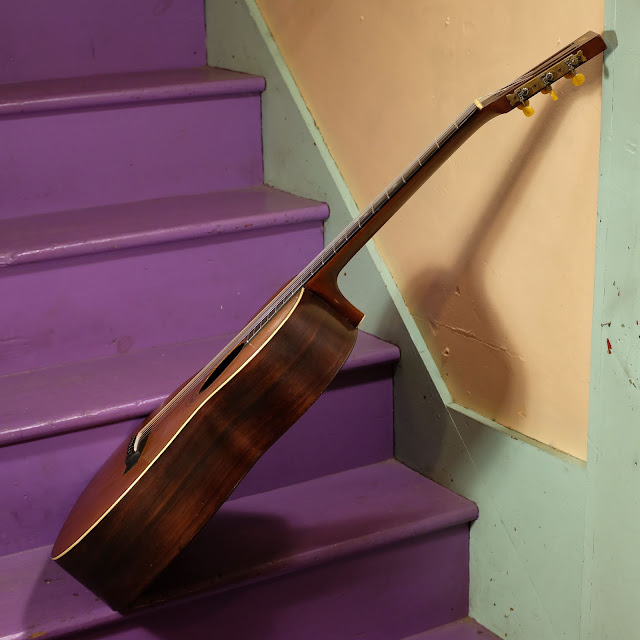1890s Bruno 00-Size 12-Fret Flattop Guitar
This guitar ticks-off a lot of desirable (and rarer, for the time) features -- Brazilian rosewood back and sides, 00-size body with 12-fret joint, finely-cut bracing, and a classic aesthetic. After work, it also sounds lush, full, and velvety. It's got plenty of volume for a fingerpicker, too, and the wide nut one might prefer for that style. When it was built, it was probably intended for gut strings, but I have it strung with 46w-10 steel and the bracing is quite content with that.
It's really hard to figure-out who actually made this guitar exactly, though. It has elements from several different makers I've encountered from the time, but the finish crazing, the (broken) original bridge's style, lightly-radiused fretboard, and the gorgeous rosewood suggest Haynes/Bay State to me. I worked on a smaller-sized Bruno-branded Haynes (also an "I think") a few years ago so there's that link, at least. It also has a 15779 serial number stamped at the headstock which would translate to 1895 on the Bay State charts and -- guess what -- there's 1895 stamped on the back of the headstock!
To further complicate matters, the neckblock bears the Bruno mark and serial 6794. The neck joint is also not a normal Bay State-style thin tenon joint -- this one looks like one of those but has a very shallow dovetail instead. Still, I'm pretty certain this was made by Haynes. I'm hoping our resident expert Mr. Brad will chime-in on this one.
Anyhow, the simple fact of the matter is that this is a great guitar, made from upscale materials, and it's survived in relatively good shape despite all the finish weathering.
Work included: a neck reset, fret level/dress, side dots install, new ebony pyramid bridge, brace regluing to the back, seam repairs, one replacement fret, one replacement tuner shaft and gear, a new bone (compensated) saddle, and new ebony pins at the bridge and endblock. It has a straight neck, the frets have good life left in them, and it plays with bang-on 3/32" EA and 1/16" DGBE action at the 12th fret, strung with 46w-10 gauges. There's room for the saddle to come down a bunch, too, if need-be.
Scale length: 24 7/8"
Nut width: 1 7/8"
String spacing at nut: 1 5/8"
String spacing at saddle: 2 5/16"
Nut width: 1 7/8"
String spacing at nut: 1 5/8"
String spacing at saddle: 2 5/16"
Body length: 19 7/8"
Lower bout width: 14 3/8"
Upper bout width: 10 1/4"
Lower bout width: 14 3/8"
Upper bout width: 10 1/4"
Waist width: 8 1/2"
Side depth at endpin: 4 1/4"
Top wood: solid spruce
Back/sides: solid Brazilian rosewood
Neck wood: Spanish cedar
Fretboard: ebony
Back/sides: solid Brazilian rosewood
Neck wood: Spanish cedar
Fretboard: ebony
Neck shape: 16-20" radius board, medium-big soft-V rear
Bridge: ebony
Nut: original bone
Saddle: new bone
Condition notes: it's mostly crack-free but does have one (old-repair) hairline crack on the sides at the endpin area and two smaller hairline cracks on either side of that towards the back/side seam. There's also one tiny hairline crack at the very end of the fretboard running to the soundhole. All of these are stable and good to go. The bridge, saddle, and pins are all replaced but the rest of the guitar is original. The fretboard extension over the body drops-off from the rest of the fretboard. It plays normal to fret 14, however. There is just the lightest "shadow" of a tailpiece on the lower bout and 3 filled screwholes above the endpin. A 1910s-era tailpiece had been added to it at some point.
There's a rosewood headstock veneer.
The board has pearl dot inlay.


























Comments
Same headstock with inlaid Bruno logo. Same pearl dots on 5th, 7th, and 9th frets. Brazilian rosewood back and sides and spruce top. Similar but not exactly the same rosette inlays. Front and rear ivroid binding and similar purfling around the perimeter on the front.
My headstock stamped # is 16437, just 658 guitars after yours, and the serial # inside on the heel block is 7378 ...just 584 from yours.
Same pryamid bridge. My tuners were changed to ones with black knobs, but I can still see old screw holes above and below my tuners where the outermost screws of the old tuners would have been mounted.
I can send photos of you let me know where to send them.
Trying to roughly date this guitar so any feedback from you is very much appreciated.
Thanks in advance.
Al Tirella